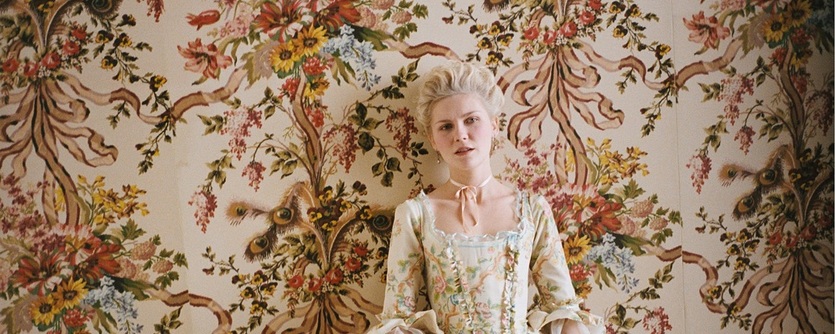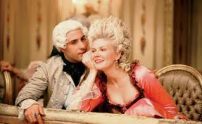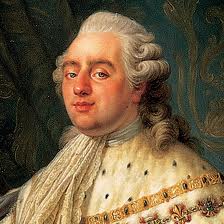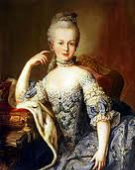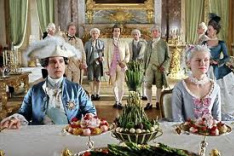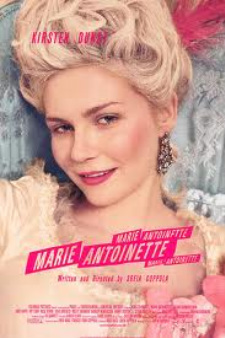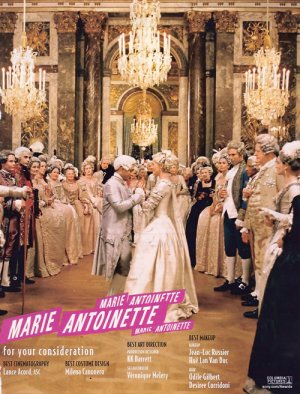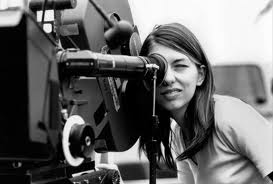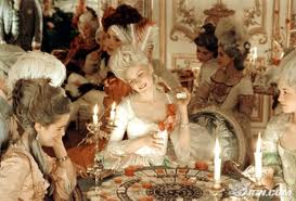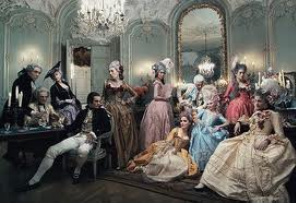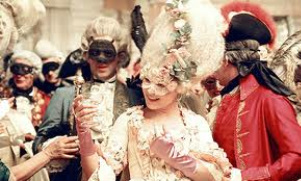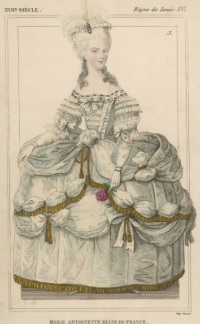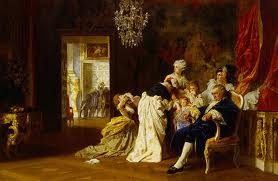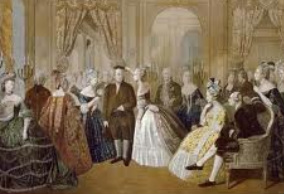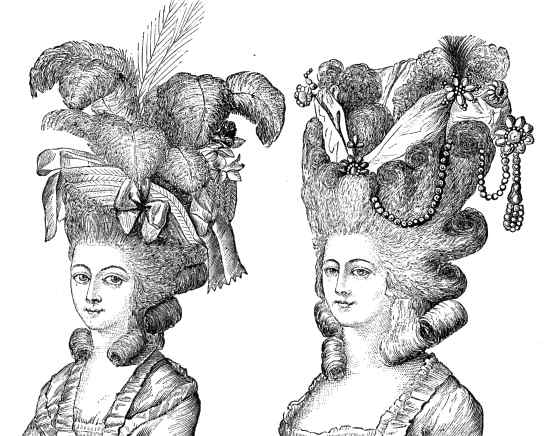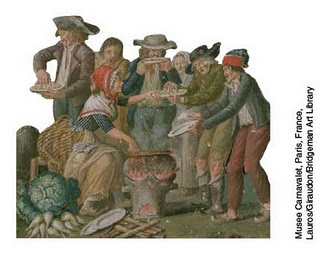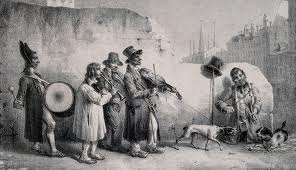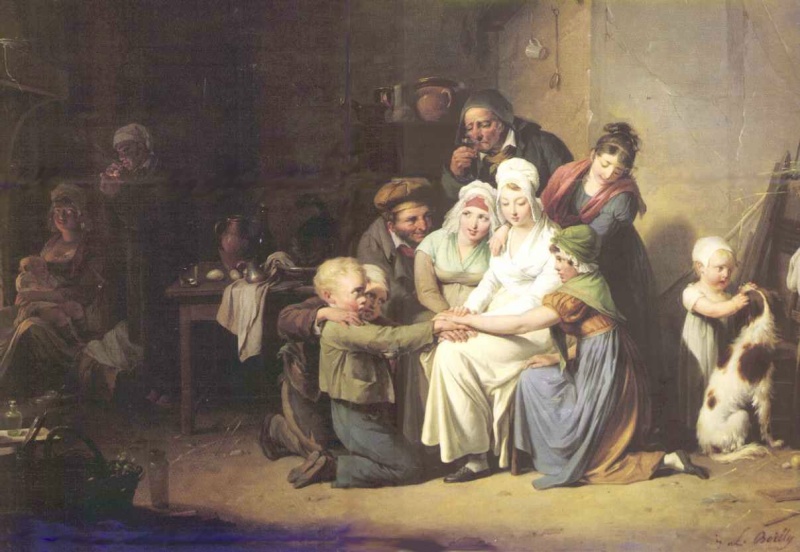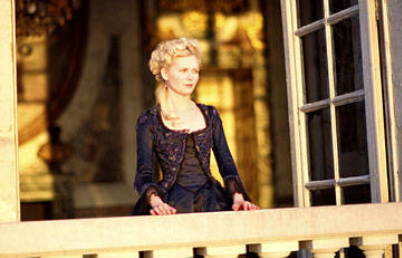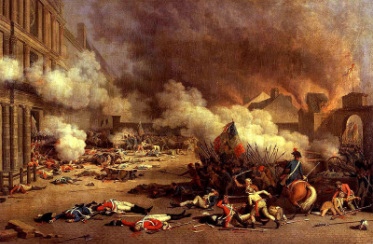Marie Antoinette (2006) Dir: Sofia Coppola
The real royal couple and their cinematic counterparts
Sofia Coppola's Marie Antoinette: Puerile or Insightful?
|
Sofia Coppola's 2006 biopic Marie Antoinette is about celebrity and privilege and their burdens. So was her previous film, Lost in Translation, as was her 2009 film Somewhere. All feature central characters who are rich and famous and bored. Who better than Sofia Coppola to examine their lives and their privileged social backgrounds? After all, she is the daughter of a major Hollywood film-maker, who grew up surrounded by wealth and whose friends were the relatives of Hollywood stars, directors and technicians.
Marie Antoinette was not well received by critics. It was accused of resembling the Queen and Louis XVI: superficial, frivolous, vacuous. LIke the royal couple, Coppola was infatuated with luxury and extravagance, incapable of the intellectual and moral insights that distinguished Ridicule, another film about the royal court. Coppola appeared to be endorsing, even celebrating, the values of brainless celebrities like Paris Hilton - accumulating possessions, leading an indolent lifestyle, obsessed by fashion, completely detached from the lives and interests of ordinary people, enjoying the insincere flattery of sycophants.So we have scene after scene in which leading roles appear to be played by fashionable shoes, elaborate hair styles, magnificent dresses, wonderful cakes and idle, bored courtiers.All to the background of flossy pop music: 'I Want Candy'. The result is an atmosphere of extravagance and sterility. Coppola's film also references two key aspects of celebrity culture. One is the manipulation and re-invention of the star's image, as exemplified by the careers of Madonna and Lady Gaga. By the end of the movie the Queen has unconvincingly become a protective mother who theatrically submits to the power of the crowd that has invaded the royal palace. And behind Coppola's portrayal of the court and its glamorous star lies the shadow of Princess Diana, another royal person obsessed with fashion, food, image and frivolity, vacuous and easily bored, surrounded by sycophants, and married to a rather stolid man with intellectual interests not shared by his consort. As the director's father, Francis Ford Coppola, exclaimed on seeing the his daughter's movie: "Marie-Antoinette is Lady Di!" Had Marie Antoinette possessed the cunning shrewdness of Diana,and her coterie of spin doctors, she would have sponsored celebrity charities, paid flying visits to worthy causes, and fostered the Paris media of the time in order to muzzle it. Perhaps the revolution might have been avoided. But is this emphasis on empty lifestyles and the pursuit of pleasure and indulgence a cunning trick by the director. Is Coppola ironically showing us a world of artifice and insincerity, based on consumption and materialism, heading for disasters - personal,social and political- that only become clear by the end of the movie.Is she saying 'See - nothing has changed. Conspicuous consumption and power without responsibility are still with us'. But if this is Coppola's subtle purpose, then she undermines it by narrowing her focus to the royal court, excluding reference to the grimmer world outside Versailles, and leaving to the end perfunctory notes of gloom - the oblique but disquieting reference to the death of a royal child, and an angry mob breaking into the royal palace. These doses of realism arrive too late in the film. There is no mention of the Queen's appalling treatment at the hands of the revolutionaries, nor of her dignified and courageous behaviour. The 1938 Hollywood Marie Antoinette and the 1950s Anglo-French Shadow of the Guillotine don't make this mistake.Ultimately, both give us someone to admire, rather than a vacuous,idle spendthrift. What Coppola provides us with, intentionally or not, is an insight into modern celebrity culture. The cultural historian Antoine Lilti regards the Queen as a perfect illustration of what he calls "the culture of celebrity". He traces the birth of this cultural phenomenon to mid-eighteenth century Paris and London. Lilti agrees with Coppola's movie that there is an affinity between the French queen and the English princess. Lilti also sees affinities between the music and movie idols Elvis Presley and Marilyn Monroe and Voltaire and Rousseau, the famous French authors and philosophers of the late eighteenth century. Both sets of became cultural icons in their respective spheres. [Antoine Lilti, Figures publiques: L'Invention de la celebrite: Paris,2014]; Robert Darnton, "How to become a celebrity" New York review of Books LXII, 9 2015 |
What Marie Antoinette Really Wore
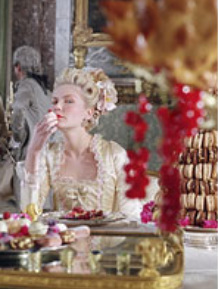
The author Caroline Weber's book Queen of Fashion: What Marie Antoinette Wore to the Revolution, and Anne Hollander's excellent article about it in Slate magazine, reveal fascinating insights into the significance of the Queen's obsession with fashions. Hollander explains Weber's idea that Marie Antoinette "took up pointed, disturbing fashions to give herself a visible autonomy and personal force that tradition didn't provide". Arriving at Court as a young teenager, removed from her family, in a strange country, she was -and remained - "politically ignorant and inept".So "Marie Antoinette may well have thought that her personal style was all she could manipulate". Her intelligent and observant brother Joseph tried vainly to warn his sister. He noted, the historian Simon Schama writes, that she "wanted the privileges and indulgences of monarchy while being free to pretend that she was really a private individual." [Simon Schama, Citizens a chronicle of the French revolution New York, 1989, p.213] This of course encapsulated Diana's own attitude. But she was the wife of a royal heir lacking any political power and few significant responsibilities in contrast to Marie Antoinette, a Queen married to a King with immense power and responsibilities
As both Weber and Hollander make clear, the young Queen's rejection of the courtly fashions of the day and her innovations of dress and style, such as "poufs", metre-high piles of hair replete with jewels and other valuables, ultimately earned her the court's disfavour and the scorn of ordinary people. "Her expensive modern glamour was enhancing only herself, not the monarchy" writes Hollander. She ignored her mother Maria Theresa's warning: "A Queen can only degrade herself by this sort of extravagance ion difficult times." The Queen mistook the flattery of imitation by her fellow aristocrats at Versailles for respect and approval. Her ill-advised love affairs were unexceptional by the standards of the court, but they provided further ammunition for her many critics. Ironically, the greatest scandal the Queen was associated with - the "Affair of the Diamond Necklace", an event involving an enormous and ruinously expensive necklace originally designed for the former King Louis XV's mistress Madame du Barry - was not Marie-Antoinette's fault.
As both Weber and Hollander make clear, the young Queen's rejection of the courtly fashions of the day and her innovations of dress and style, such as "poufs", metre-high piles of hair replete with jewels and other valuables, ultimately earned her the court's disfavour and the scorn of ordinary people. "Her expensive modern glamour was enhancing only herself, not the monarchy" writes Hollander. She ignored her mother Maria Theresa's warning: "A Queen can only degrade herself by this sort of extravagance ion difficult times." The Queen mistook the flattery of imitation by her fellow aristocrats at Versailles for respect and approval. Her ill-advised love affairs were unexceptional by the standards of the court, but they provided further ammunition for her many critics. Ironically, the greatest scandal the Queen was associated with - the "Affair of the Diamond Necklace", an event involving an enormous and ruinously expensive necklace originally designed for the former King Louis XV's mistress Madame du Barry - was not Marie-Antoinette's fault.
The Movie's Portrayal of Court Life
Recent scholarship has basically confirmed that the VersaIles court under Marie and her husband was a majpr factor in severly weakening the prestige and power of the French monarchy. On a personal level, hostorians have passed scathing judgements on both King and Queen. Thus Prof. T.C.W. Blanning's assessment of Marie Antoinette: "headstrong, fun-loving, self-centred and stupid." He is especially critical of her behaviour at Court. "By gathering around her a favoured few, by exploiting her hold of her husband to make and unmake appointments, and indulging in reckless extravagance, she provided the gossip-makers with an embarras de riches." It was therefore easy for contemporary pamphleteers, the equivalent of today's tweets and Facebook pages, to portray her as L'Autrichienne en goguettes -'the Austrian bitch on the spree'. T.C.W.Blanning, The French Revolution Class War or Culture Clash?, [2nd ed. New York 1998]pp.36-37
